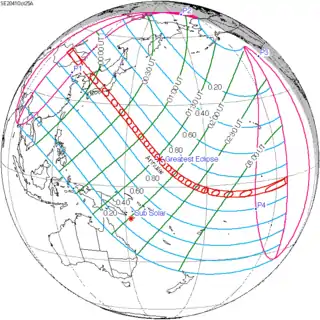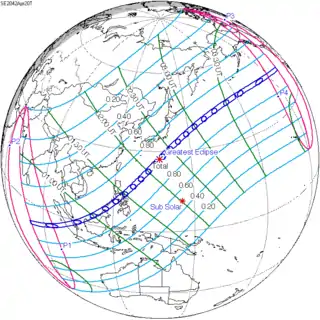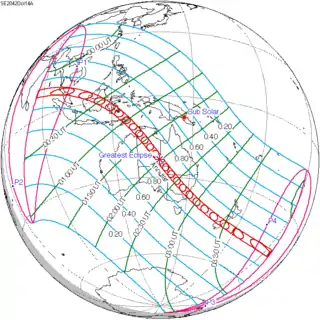| Solar eclipse of April 30, 2041 | |
|---|---|
 Map | |
| Type of eclipse | |
| Nature | Total |
| Gamma | −0.4492 |
| Magnitude | 1.0189 |
| Maximum eclipse | |
| Duration | 111 sec (1 m 51 s) |
| Coordinates | 9°36′S 12°12′E / 9.6°S 12.2°E |
| Max. width of band | 72 km (45 mi) |
| Times (UTC) | |
| Greatest eclipse | 11:52:21 |
| References | |
| Saros | 129 (53 of 80) |
| Catalog # (SE5000) | 9599 |
A total solar eclipse will occur on Tuesday, April 30, 2041. A solar eclipse occurs when the Moon passes between Earth and the Sun, thereby totally or partly obscuring the image of the Sun for a viewer on Earth. A total solar eclipse occurs when the Moon's apparent diameter is larger than the Sun's, blocking all direct sunlight, turning day into darkness. Totality occurs in a narrow path across Earth's surface, with the partial solar eclipse visible over a surrounding region thousands of kilometres wide.
Images

Animated path
Related eclipses
Solar eclipses of 2040–2043
This eclipse is a member of a semester series. An eclipse in a semester series of solar eclipses repeats approximately every 177 days and 4 hours (a semester) at alternating nodes of the Moon's orbit.[1]
| Solar eclipse series sets from 2040–2043 | ||||
|---|---|---|---|---|
| Ascending node | Descending node | |||
| 119 | May 11, 2040 Partial |
124 | November 4, 2040 Annular | |
| 129 | April 30, 2041 Total |
134 | October 25, 2041 Annular | |
| 139 | April 20, 2042 Total |
144 | October 14, 2042 Annular | |
| 149 | April 9, 2043 Total (non-central) |
154 | October 3, 2043 Annular (non-central) | |
Saros 129
It is a part of Saros cycle 129, repeating every 18 years, 11 days, containing 80 events. The series started with partial solar eclipse on October 3, 1103. It contains annular eclipses on May 6, 1464 through March 18, 1969, hybrid eclipses from March 29, 1987 through April 20, 2023 and total eclipses from April 30, 2041 through July 26, 2185. The series ends at member 80 as a partial eclipse on February 21, 2528. The longest duration of totality was 3 minutes, 43 seconds on June 25, 2131 . All eclipses in this series occurs at the Moon’s ascending node.[2]
| Series members 46–56 occur between 1901 and 2100: | ||
|---|---|---|
| 46 | 47 | 48 |
 February 14, 1915 |
 February 24, 1933 |
 March 7, 1951 |
| 49 | 50 | 51 |
 March 18, 1969 |
 March 29, 1987 |
 April 8, 2005 |
| 52 | 53 | 54 |
 April 20, 2023 |
 April 30, 2041 |
 May 11, 2059 |
| 55 | 56 | |
 May 22, 2077 |
 June 2, 2095 | |
Inex series
This eclipse is a part of the long period inex cycle, repeating at alternating nodes, every 358 synodic months (≈ 10,571.95 days, or 29 years minus 20 days). Their appearance and longitude are irregular due to a lack of synchronization with the anomalistic month (period of perigee). However, groupings of 3 inex cycles (≈ 87 years minus 2 months) comes close (≈ 1,151.02 anomalistic months), so eclipses are similar in these groupings.
| Inex series members between 1901 and 2100: | ||
|---|---|---|
 July 20, 1925 (Saros 125) |
 June 30, 1954 (Saros 126) |
 June 11, 1983 (Saros 127) |
 May 20, 2012 (Saros 128) |
 April 30, 2041 (Saros 129) |
 April 11, 2070 (Saros 130) |
 March 21, 2099 (Saros 131) |
||
Metonic series
The metonic series repeats eclipses every 19 years (6939.69 days), lasting about 5 cycles. Eclipses occur in nearly the same calendar date. In addition, the octon subseries repeats 1/5 of that or every 3.8 years (1387.94 days). All eclipses in this table occur at the Moon's ascending node.
| 21 eclipse events, progressing from south to north between July 13, 2018, and July 12, 2094 | ||||
|---|---|---|---|---|
| July 12–13 | April 30-May 1 | February 16–17 | December 5–6 | September 22–23 |
| 117 | 119 | 121 | 123 | 125 |
 July 13, 2018 |
 April 30, 2022 |
 February 17, 2026 |
 December 5, 2029 |
 September 23, 2033 |
| 127 | 129 | 131 | 133 | 135 |
 July 13, 2037 |
 April 30, 2041 |
 February 16, 2045 |
 December 5, 2048 |
 September 22, 2052 |
| 137 | 139 | 141 | 143 | 145 |
 July 12, 2056 |
 April 30, 2060 |
 February 17, 2064 |
 December 6, 2067 |
 September 23, 2071 |
| 147 | 149 | 151 | 153 | 155 |
 July 13, 2075 |
 May 1, 2079 |
 February 16, 2083 |
 December 6, 2086 |
 September 23, 2090 |
| 157 | ||||
 July 12, 2094 | ||||
References
- ↑ van Gent, R.H. "Solar- and Lunar-Eclipse Predictions from Antiquity to the Present". A Catalogue of Eclipse Cycles. Utrecht University. Retrieved 6 October 2018.
- ↑ Espenak, F. "NASA Catalog of Solar Eclipses of Saros 129". eclipse.gsfc.nasa.gov.
.jpg.webp)

